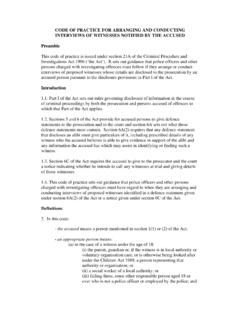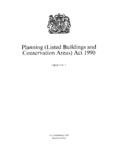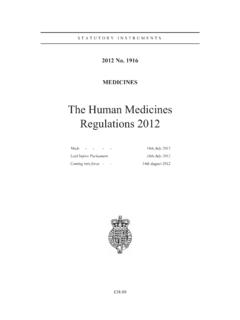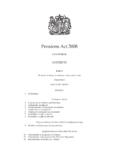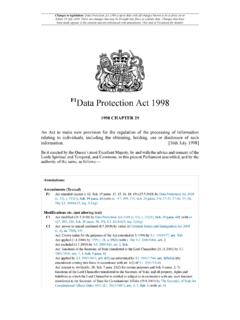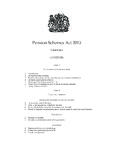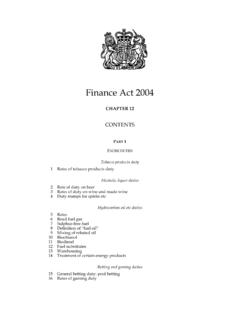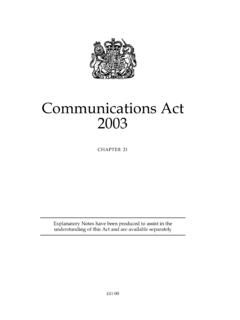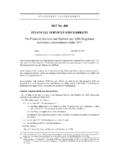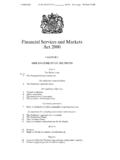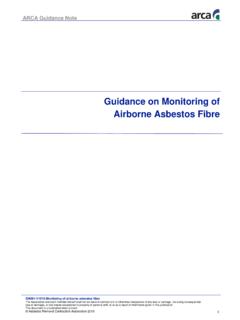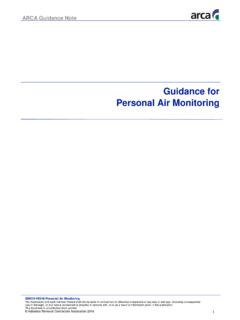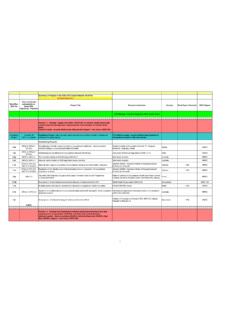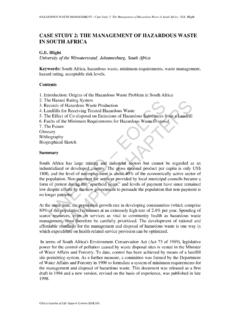Transcription of 2012 No. 632 HEALTH AND SAFETY - …
1 STATUTORY INSTRUMENTS 2012 No. 632 HEALTH AND SAFETY The Control of asbestos Regulations 2012 Made - - - - 27th February 2012 Laid before Parliament 5th March 2012 Coming into force - - 6th April 2012 The Secretary of State makes these Regulations in exercise of the powers conferred by sections 15(1), (2), (3), (4), (5), (6)(b), (9),18(2), 80(1) and 82(3) of, and paragraphs 1(1) to (4), 3(2), 4, 6, 8 to 11, 13(1) and (3), 14, 15(1), 16 and 20 of Schedule 3 to, the HEALTH and SAFETY at Work etc. Act 1974(a) ( the 1974 Act ) and section 2(2) of the European Communities Act 1972 ( the 1972 Act )(b). In doing so the Secretary of State gives effect without modifications to proposals submitted to him by the HEALTH and SAFETY Executive ( the Executive ) under section 11(3) of the 1974 Act after consulting in accordance with section 50(3) of that Act, and it appearing expedient to him after consulting such bodies as appear to him to be appropriate in accordance with section 80(4) of that Act.
2 The Secretary of State is a Minister designated for the purpose of section 2(2) of the 1972 Act in relation to the regulation and control of classification, packaging and labelling of dangerous substances and preparations(c), and persistent organic pollutants, dangerous substances, preparations and chemicals(d). PART 1 Preliminary Citation and commencement 1. These Regulations may be cited as the Control of asbestos Regulations 2012 and come into force on 6th April 2012. Interpretation 2. (1) In these Regulations (a) 1974 ; sections 11(3) and 15(4) were amended by the Legislative Reform ( HEALTH and SAFETY Executive) Order 2008 ( 2008/960); sections 15 and 50 were amended by the Employment Protection Act 1975 ( ), Schedule 15, paragraphs 6 and 16 respectively.
3 (b) 1972 (c) 1976/897. (d) 2006/608. 2 adequate means adequate having regard only to the nature and degree of exposure to asbestos , and adequately must be construed accordingly; appointed doctor means a registered medical practitioner appointed for the time being in writing by the Executive for the purpose of these Regulations; approved means approved for the time being in writing by the Executive; asbestos means the following fibrous silicates (a) asbestos actinolite, CAS No 77536-66-4; (b) asbestos grunerite (amosite), CAS No 12172-73-5; (c) asbestos anthophyllite, CAS No 77536-67-5; (d) chrysotile, CAS No 12001-29-5 or CAS No 132207-32-0; (e) crocidolite, CAS No 12001-28-4; and (f) asbestos tremolite, CAS No 77536-68-6, and reference to CAS followed by a numerical sequence are references to CAS Registry Numbers assigned to chemicals by the Chemical Abstracts Service, a division of the American Chemical Society; asbestos cement means a material which is predominantly a mixture of cement and chrysotile and which when in a dry state absorbs less than 30% water by weight; asbestos coating means a surface coating which contains asbestos for fire protection, heat insulation or sound insulation but does not include textured decorative coatings; asbestos insulating board (AIB) means any flat sheet, tile or building board consisting of a mixture of asbestos and other material except (a) asbestos cement.
4 Or (b) any article of bitumen, plastic, resin or rubber which contains asbestos , and the thermal or acoustic properties of the article are incidental to its main purpose; asbestos insulation means any material containing asbestos which is used for thermal, acoustic or other insulation purposes (including fire protection) except (a) asbestos cement, asbestos coating or asbestos insulating board; or (b) any article of bitumen, plastic, resin or rubber which contains asbestos and the thermal and acoustic properties of that article are incidental to its main purpose; the control limit means a concentration of asbestos in the atmosphere when measured in accordance with the 1997 WHO recommended method, or by a method giving equivalent results to that method approved by the Executive, of fibres per cubic centimetre of air averaged over a continuous period of 4 hours; control measure means a measure taken to prevent or reduce exposure to asbestos (including the provision of systems of work and supervision, the cleaning of workplaces, premises, plant and equipment, and the provision and use of engineering controls and personal protective equipment); emergency services include (a) police, fire, rescue and ambulance services; (b) Her Majesty s Coastguard; employment medical adviser means an employment medical adviser appointed under section 56 of the 1974 Act(a).
5 Enforcing authority means the Executive, local authority or Office of Rail Regulation, determined in accordance with the provisions of the HEALTH and SAFETY (Enforcing Authority) (a) 1974 ; section 56(3) was amended by the Medical Act 1983 (Amendment Order) 2002, 2002/3135. 3 Regulations 1998(a) and the provisions of the HEALTH and SAFETY (Enforcing Authority for Railways and Other Guided Transport Systems) Regulations 2006(b); ISO 17020 means European Standard EN ISO/IEC 17020, General criteria for the operation of various types of bodies performing inspection as revised or reissued from time to time and accepted by the Comit Europ en de Normalisation lectrotechnique (CEN/CENELEC)(c).
6 ISO 17025 means European Standard EN ISO/IEC 17025, General requirements for the competence of testing and calibration laboratories as revised or reissued from time to time and accepted by the Comit Europ en de Normalisation lectrotechnique (CEN/CENELEC)(d); licensable work with asbestos is work (a) where the exposure to asbestos of employees is not sporadic and of low intensity; or (b) in relation to which the risk assessment cannot clearly demonstrate that the control limit will not be exceeded; or (c) on asbestos coating; or (d) on asbestos insulating board or asbestos insulation for which the risk assessment (i) demonstrates that the work is not sporadic and of low intensity, or (ii) cannot clearly demonstrate that the control limit will not be exceeded, or (iii) demonstrates that the work is not short duration work; medical examination includes any laboratory tests and X-rays that a relevant doctor may require; personal protective equipment means all equipment (including clothing) which is intended to be worn or held by a person at work and which protects that person against one or more risks to that person s HEALTH , and any addition or accessory designed to meet that objective; relevant doctor means an appointed doctor or an employment medical adviser.
7 In relation to work with asbestos which is not licensable work with asbestos and is not exempted by regulation 3(2) relevant doctor also includes an appropriate fully registered medical practitioner who holds a licence to practice; risk assessment means the assessment of risk required by regulation 6(1)(a); textured decorative coatings means decorative and textured finishes, such as paints and ceiling and wall plasters which are used to produce visual effects and which contain asbestos . These coatings are designed to be decorative and any thermal or acoustic properties are incidental to their purpose, and the 1997 WHO recommended method means the publication Determination of airborne fibre concentrations. A recommended method, by phase-contrast optical microscopy (membrane filter method) , WHO (World HEALTH Organisation), Geneva 1997(e). (2) A reference to work with asbestos in these Regulations includes (a) work which consists of the removal, repair or disturbance of asbestos or materials containing asbestos ; (b) work which is ancillary to such work; and (c) supervision of such work and such ancillary work.
8 (3) For the purposes of these Regulations, work with asbestos is not short duration work if, in any seven day period (a) , as amended by 1999/2024, 1999/3232, 2002/2675, 2004/3168, 2005/1082, 2005/1541, 2005/2060, 2006/484, 2006/557, 2006/2739, 2007/320, 2007/2598, 2008/960, 2009/693 and 2009/716. (b) 2006/557, as amended by 2006/2739, 2007/320, 2007/1573 and 2008/2323. (c) The most recent version is reference number EN ISO/IEC 17020: 2004, accepted by CEN/CENELEC on 15th July 2004. (d) The most recent version is reference number EN ISO/IEC 17025:2005, accepted by CEN/CENELEC on 15th March 2005. (e) ISBN 92 4 154496 1. 4 (a) that work, including any ancillary work liable to disturb asbestos , takes more than two hours; or (b) any person carries out that work for more than one hour.
9 (4) For the purpose of these Regulations, no exposure to asbestos will be sporadic and of low intensity if the concentration of asbestos in the atmosphere, when measured in accordance with the 1997 WHO recommended method or by a method giving equivalent results to that method and approved by the Executive, exceeds or is liable to exceed the concentration approved in relation to a specified reference period for the purposes of this paragraph by the Executive. (5) For the purposes of these Regulations, except in accordance with regulation 11(3) and (5), in determining whether an employee is exposed to asbestos or whether the extent of such exposure exceeds the control limit, no account must be taken of respiratory protective equipment which, for the time being, is being worn by that employee. (6) In these Regulations the provisions of Appendix 7 to Annex XVII of the REACH Regulations(a), which determine the labelling requirements of articles containing asbestos , are reproduced in Schedule 2 (with minor changes reflecting the practical implementation of the requirements).
10 Application of these Regulations 3. (1) These Regulations apply to a self-employed person as they apply to an employer and an employee and as if that self-employed person were both an employer and an employee. (2) Regulations 9 (notification of work with asbestos ), 18(1)(a) (designated areas) and 22 ( HEALTH records and medical surveillance) do not apply where (a) the exposure to asbestos of employees is sporadic and of low intensity; and (b) it is clear from the risk assessment that the exposure to asbestos of any employee will not exceed the control limit; and (c) the work involves (i) short, non-continuous maintenance activities in which only non-friable materials are handled, or (ii) removal without deterioration of non-degraded materials in which the asbestos fibres are firmly linked in a matrix, or (iii) encapsulation or sealing of asbestos -containing materials which are in good condition, or (iv) air monitoring and control, and the collection and analysis of samples to ascertain whether a specific material contains asbestos .
